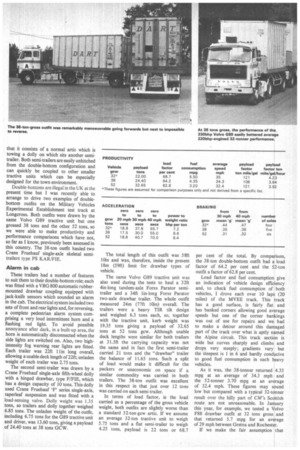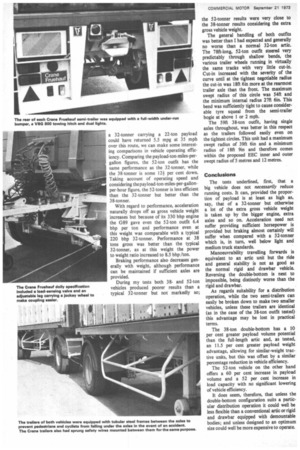A productivity and handling comparison of 38-ton and 52-ton double bottom outfits
Page 98

Page 99

Page 100

If you've noticed an error in this article please click here to report it so we can fix it.
by Gibb Grace
Pictures by Harry Roberts WITH the pressure on operators to be more efficient on the one hand and the beginnings of bans on long vehicles in cities on the other, all normal compromises seem to fail to produce an answer to the ideal distribution truck and a new approach is needed. Highercapacity trucks are needed to reduce tonmile costs and as the public wants only small vehicles in towns and cities, the load must be easily broken down for final delivery by small vehicles. Any undue handling of the goods is wasteful and expensive and thus must be reduced to a minimum.
One answer to this problem and one which has an increasing number of supporters, particularly in the grocery trades, is the American-named double-bottom. This type of vehicle — which is familiar in the USA — is unlike a straight drawbar combination M that it consists of a normal artic which is towing a dolly on which sits another semitrailer. Both semi-trailers are easily unhitched from the double-bottom configuration and can quickly be coupled to other smaller tractive units which can be especially designed for the town environment.
Double-bottoms are illegal in the UK at the present time but I was recently able to arrange to drive two examples of doublebottom outfits on the Military Vehicles Experimental Establishment test track at Longcross. Both outfits were drawn by the same Volvo G89 tractive unit but one grossed 38 tons and the other 52 tons, so we were able to make productivity and performance comparisons which have not, so far as I know, previously been assessed in this country. The 38-ton outfit hauled two Crane Fruehauf single-axle skeletal semitrailers type PS KAR/FIE.
Alarm in cab These trailers had a number of features to suit them to their double-bottom role; each was fitted with a VBG 800 automatic rubbermounted drawbar coupling equipped with jack-knife sensors which sounded an alarm in the cab. The electrical system included two sets of front and rear lights and, for reversing, a complete pedestrian alarm system comprising a very loud intermittent horn and a flashing red light. To avoid possible annoyance after dark, in a built-up area, the horn is automatically disconnected when the side lights are switched on. Also, two highintensity fog warning rear lights are fitted. Each trailer was 22ft I 1 in long overall, allowing a usable deck length of 22ft; unladen weight of each trailer was 2.75 tons.
The second semi-trailer was drawn by a Crane Fruehauf single-axle fifth-wheel dolly with a hinged drawbar, type F/FIE, which has a design capacity of 10 tons. This dolly used Crane Fruehauf 'F' series single-axle, taperleaf suspension and was fitted with a load-sensing valve. Dolly weight was 1.35 tons, so trailers and dolly together weighed 6.85 tons. The unladen weight of the outfit, including 6.75 tons for the G89 tractive unit and driver, was 13.60 tons, giving a payload of 24.40 tons at 38 tons GCW. The total length of this outfit was 58ft 10in and was, therefore, inside the present 18m (59ft) limit for drawbar types of vehicle.
The same Volvo G89 tractive unit was also used during the tests to haul a 32ft 4in-long tandem-axle Forss Parator semitrailer and a 34ft lin-long Forss Parator two-axle drawbar trailer. The whole outfit measured 24m (771t 10in) overall. The trailers were a heavy TIR tilt design and weighed 6.3 tons each, so, together with the tractive unit, kerb weight was 19.35 tons giving a payload of 32.65 tons at 52 tons gcw. Although usable deck lengths were similar for both trailers at 3 I.5ft the carrying capacity was not the same and in fact the first semi-trailer carried 21 tons and the "drawbartrailer the balance of 11.65 tons. Such a split of load would make it difficult for the packers or uneconomic on space if a similar commodity was carried in both trailers. The 38-ton outfit was excellent in this respect in that just over 12 tons was carried on each semi-trailer.
In terms of load factor, ie the load carried as a percentage of the gross vehicle weight, both outfits are slightly worse than a standard 32-ton-gcw attic. If we assume an average 32-ton tractive unit to weigh 5.75 tons and a flat semi-trailer to weigh 4.25 tons, payload is 22 tons or 68.7
per cent of the total. By comparison, the 38-ton double-bottom outfit had a load factor of 64.2 per cent and the 52-ton outfit a factor of 62.8 per cent.
Load factor and fuel consumption give an indication of vehicle design efficiency and, to check fuel consumption of both vehicles, I drove each over 10 laps (20 miles) of the MVEE track. This track has a good surface, is fairly flat and has banked corners allowing good average speeds but one of the corner bankings was out of use for repairs and we had to make a detour around this damaged part of the track over what is aptly named the Alpine circuit. This track section is wide but curves sharply and climbs and drops very steeply ; gradients vary but the steepest is 1 in 6 and hardly conducive to good fuel consumption in such heavy vehicles.
As it was, the 38-tonner returned 4.35 mpg at an average of 34.3 mph and the 52-tonner 3.70 mpg at an average of 32.4 mph. These figures may sound low but compared with a typical 32-tonner result over the hilly part of CM's Scottish route are not unreasonable. In January this year, for example, we tested a Volvo F88 drawbar outfit at 32 tons gross and that returned 5.7 mpg for an average of 29 mph between Gretna and Rochester.
If we make the fair assumption that a 32-tonner carrying a 22-ton payload could have returned 5.5 mpg at 35 mph over this route, we can make some interesting comparisons in vehicle operating efficiency. Comparing the payload-ton-miles-pergallon figures. the 52-ton outfit has the same performance as the 32-tonner, while the 38-tonner is some 12; per cent down. Taking account of operating speed and considering thepayload-ton-miles-per-gallonper-hour figure. the 52-tonner is less efficient than the 32-tonner but better than the 38-ton ner.
With regard to performance, acceleration naturally drops off as gross vehicle weight increases but because of its 330 bhp engine the 089 gave even the 52-ton outfit 6.4 bhp per ton and performance even at this weight was comparable with a typical 220 bhp 32-tonner. Performance at 38 tons gross was better than the typical 32-tonner, as at this weight the power to weight ratio increased to 8.5 bhp /ton.
Braking performance also decreases generally with weight, although performance can be maintained if sufficient axles are provided.
During my tests both 38and 52-ton vehicles produced poorer results than a typical 32-tonner but not markedly so;
the 52-tonner results were very close to the 38-tonner results considering the extra gross vehicle weight.
The general handling of both outfits was better than I had expected and generally no worse than a normal 32-ton attic. The 78ft-long, 52-ton outfit steered very predictably through shallow bends, the various trailer wheels running in virtually the same tracks with very little cut-in. Cut-in increased with the severity of the curve until at the tightest negotiable radius the cut-in was 18ft 6in more at the rearmost trailer axle than the front. The maximum swept radius of this circle was 5411 and the minimum internal radius 2711 6in. This bend was sufficiently tight to cause considerable tyre squeal from the semi-trailer bogie at above 1 or 2 mph.
The 59ft 38-ton outfit, having single axles throughout, was better in this respect as the trailers followed easily even on the tightest circles. This unit had a maximum swept radius of 39ft 6in and a minimum radius of 18ft 9in and therefore comes within the proposed EEC inner and outer swept radius of 5 metres and 12 metres.
Conclusions The tests underlined, first, that a big vehicle does not necessarily reduce running costs. It can, provided the proportion of payload is at least as high as, say, that of a 32-tonner but otherwise a lot of the extra gross vehicle weight is taken up by the bigger engine, extra axles and so on. Acceleration need not suffer providing sufficient horsepower is provided but braking almost certainly will suffer when compared with a 32-tonner which is, in turn, well below light and medium truck standards.
Manoeuvrability travelling forwards is equivalent to an attic unit but the ride and general stability is not as good as the normal rigid and drawbar vehicle. Reversing the double-bottom is next to impossible, being distinctly worse than the rigid and drawbar.
As regards suitability for a distribution operation, while the two semi-trailers can easily be broken down to make two smaller vehicles, unless these trailers are identical (as in the case of the 38-ton outfit tested) this advantage may be lost in practical terms.
The 38-ton double-bottom has a 10 per cent greater payload volume potential than the full-length attic and, as tested, an 11.5 per cent greater payload weight advantage, allowing for similar-weight tractive units, but this was offset by a similar percentage reduction in vehicle efficiency.
The 52-ton vehicle on the other hand offers a 60 per cent increase in payload volume and a 52 per cent increase in load capacity with no significant lowering of vehicle efficiency.
It does seem, therefore, that unless the double-bottom configuration suits a particular distribution operation it could well be less flexible than a conventional artic or rigid and drawbar equipped with demountable bodies; and unless designed to an optimum size could well be more expensive to operate.
















































































































































































